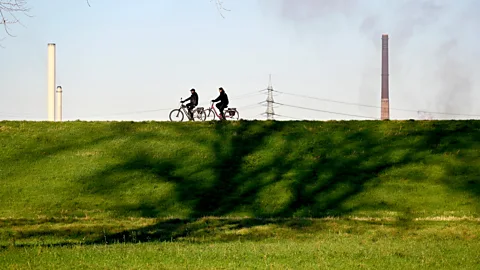During its passage through the Netherlands, the Rhine splits into several branches, forming a complex delta. On my second day, pedalling upstream, I crossed one vast tributary, the Waal, by ferry but also meandered for hours along the intricate dykes that protect the polders from encroachment by the ever-threatening sea.
I made it into Germany on my second day and joined the locals at the Stammtisch (regulars' table) at my hotel, to devour a Wienerschnitzel, washed down with a Weizenbier. I then diverted slightly from the official EV15 route and rode alone through deserted fields under vast skies. The Roman site of Xanten has a reconstruction of a full-scale amphitheatre, and the town has a connection to Siegfried, hero of the Nibelungenlied, the medieval German epic. I idled away a pleasant half hour in the shade of a giant windmill.

 Getty Images
Getty Images
The clock was ticking, and it was time to raise the tempo. I powered through Duisburg, the steel capital of Germany, fascinated but also intimidated by the brutalism of its industrial heritage. Chimneys poked 250m into the sky, and I slalomed between the last twisted, rusting remnants of heavy industry. Passing through Cologne, dark clouds bore down on the largest Gothic church in Northern Europe, which looked particularly foreboding as big black clouds gathered over it. I was so wrapped up in taking photos that I was soaked when the storm broke.
Plan your trip:
Route: The EV15 follows the Rhine for about 1,450km (900 miles), starting from the Hook of Holland and finishing at the Oberalp Pass in the Swiss Alps.
Best time to go: Between May and October for good weather and long daylight hours.
Navigation: Download EV15 GPX files and attraction maps from EuroVelo 15. The site also lists e-bike charging, repair shops and refill points.
Highlights: The Rhine Gorge and castles of the Romantic Rhine, Cologne Cathedral, Basel's Old Town, Lake Constance and the Rhine Falls.
.png)




